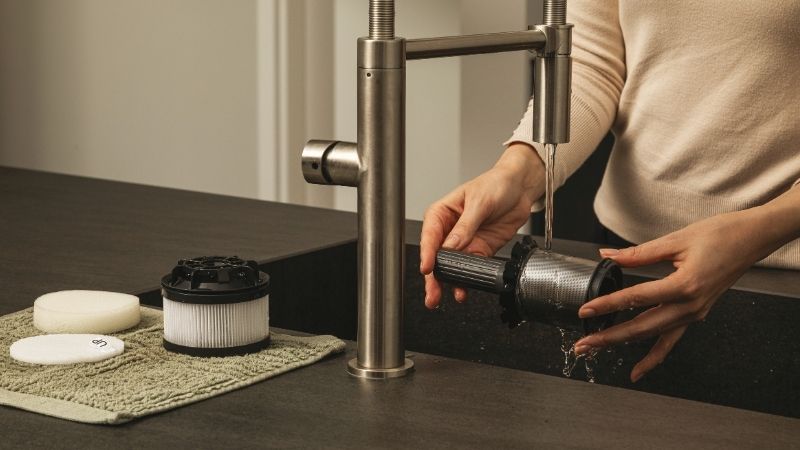Induction hobs are one of the biggest and fastest growing trends in modern kitchens and for good reason, they’re sleek, easy to clean and efficient. Induction technology seems like something out of science fiction or fantasy, the hob isn’t hot to the touch yet can boil water within minutes. With all the hype around induction hobs you might be wondering: how do induction hobs actually work? So, it isn’t exactly magic, but rather the science of electromagnetic induction.
The technology: Electromagnetism
Under each “burner” or cooking zone, induction hobs have a coil of copper wire. When electricity runs through this wire it creates a magnetic field that, when used with the right cookware, creates heat. This is the reason that only special pots and pans can be used with induction hobs. The cookware must be ferromagnetic (contain iron or a similar metal that is attracted to magnets). If the cookware does not contain cast iron or another magnetic metal, heat will not be generated by the magnetic field and the induction hob will not work.
When the magnetic material of the cookware comes into contact with the magnetic field created by the copper wire of the induction hob, electric currents are transferred into the cookware, generating direct heat. This is why the hob may be cool to the touch but the pot or pan you are using is hot, maybe even boiling.
This type of cooking technology presents many benefits and is quickly becoming an essential in the contemporary kitchen. So, what are the benefits of induction hobs and why are they a smart choice for modern kitchens?
Gas v. Induction: What are the benefits?
Although the traditional gas hob continues to be a popular choice and provides some benefits, like the ability to cook during a power cut, induction hobs have significant advantages over traditional gas hobs. These advantages are a result of the induction hob technology and how it works. So let’s take a look and compare gas v. induction hobs more in detail to see why an induction hob might be a good choice for you and your cooking needs.
Energy efficiency:
One of the biggest advantages that induction hobs have over all other types of stoves and hobs is the extremely energy efficient design. The induction technology allows for a low consumption of electricity while heating the cookware directly. This means that there is very little heat dispersion and all of the energy used is directly heating the cookware, leading to faster cook times and less energy consumption.
On the other hand, gas hobs do have some heat dispersion due to the heat generated by the flame that is not transferred directly to the cookware. Gas hobs generally have longer cook times and a higher energy consumption.
Safety:
Because induction hobs heat cookware directly, the rest of the hob is kept relatively cool, even when in use! You can touch the other parts of the hob without worrying about burns or other injuries. Induction hobs are also quick cooling, meaning that once the cookware is removed, the hob cools quickly, further reducing the risk of burns. This can be especially useful for households with small children and pets.
Gas hobs, however, have an open flame which presents a higher risk of burns, fires and other mishaps.
Precise temperature control:
One of the biggest advantages of induction hobs are the temperature sensors, digital controls and instant heat adjustment. When you change the setting on an induction hob, the electromagnetic field adjusts almost instantly, providing immediate changes in the cooking temperature. The advanced temperature sensors monitor the temperature of the cookware in real time, providing you with instant feedback so you can adjust to the perfect temperature for simmering your famous marinara sauce or melting the chocolate for your legendary deserts.
Gas hobs are favored by some people for cooking techniques like high heat searing, but in general, gas hobs have less heat precision as the flame is more difficult to regulate.
Ease of cleaning:
If all of these perks of induction hobs weren’t convincing enough, they are also renowned for being easy to clean! Because of their flat surface design, there are no grates or grills to be removed and scrubbed. A damp cloth and voila! - sparkling clean. The induction technology also contributes to their ease of cleaning. Because of the direct heat and temperature sensors, spillage and charred food on the hob is very unlikely.
Cleaning a gas hob, however, includes a few more pieces and steps such as wiping down the cooking surface and removing and soaking burner caps and grates. Spillage and burnt-on food is more common with a gas hob as there are no precise heat controls and the entire surface of the hob is heated indirectly by the burner flame.
Induction hobs: a smart choice
Gas hobs continue to be a traditional choice as many people are used to and like the feel of cooking with gas. With that being said, the induction technology has been revolutionising kitchens, introducing smart technology, and precision cooking into the common household. But they are not only for the cooking enthusiast, they also provide extra safety and hassle free cleaning, great for anyone on-the-go or families. Because of the induction technology and the perks it offers like energy efficiency, safety, precision temperature controls and easy cleaning, an induction hob just might be the right addition to your kitchen.



